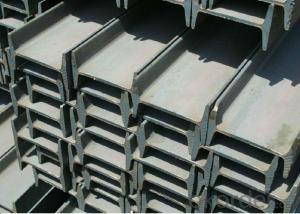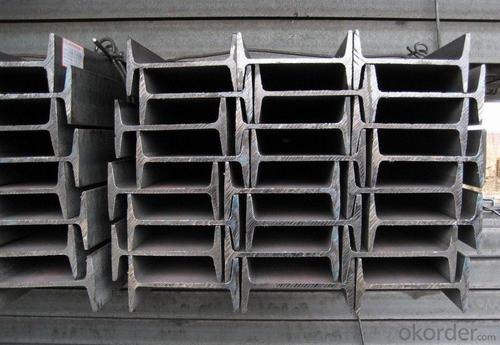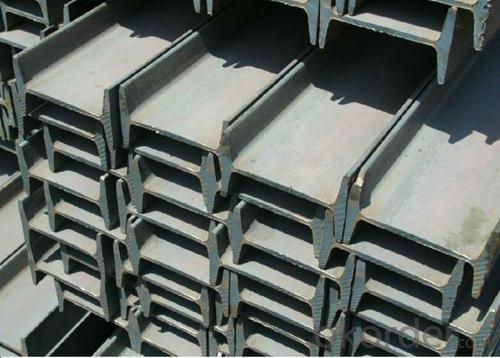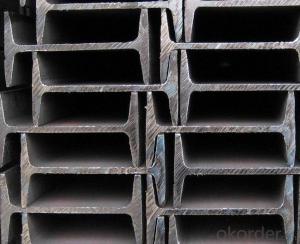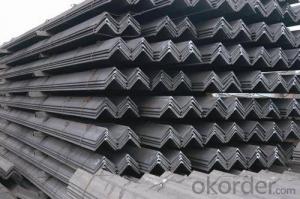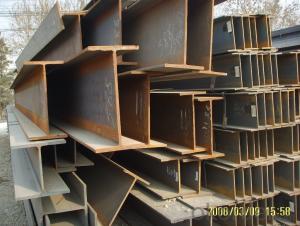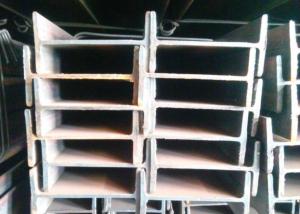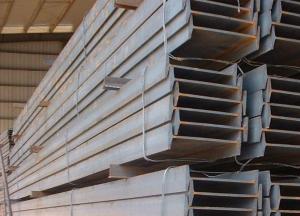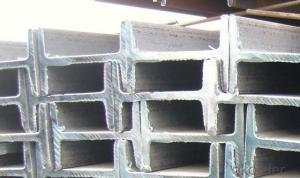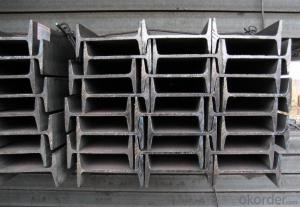European Standard IPE/IPEAA in Material Grade GB-Q235
- Loading Port:
- Tianjin
- Payment Terms:
- TT OR LC
- Min Order Qty:
- 25 m.t
- Supply Capability:
- 10000 m.t/month
OKorder Service Pledge
OKorder Financial Service
You Might Also Like
Product Description:
OKorder is offering high quality Hot Rolled Steel I-Beams at great prices with worldwide shipping. Our supplier is a world-class manufacturer of steel, with our products utilized the world over. OKorder annually supplies products to European, North American and Asian markets. We provide quotations within 24 hours of receiving an inquiry and guarantee competitive prices.
Product Applications:
1. Supporting members, most commonly in the house raising industry to strengthen timber bears under houses. Transmission line towers, etc
2. Prefabricated structure
3. Medium scale bridges
4. It is widely used in various building structures and engineering structures such as roof beams, bridges, transmission towers, hoisting machinery and transport machinery, ships, industrial furnaces, reaction tower, container frame and warehouse etc.
Product Advantages:
OKorder's Steel I-Beams are durable, strong, and resist corrosion.
Main Product Features:
· Premium quality
· Prompt delivery & seaworthy packing (30 days after receiving deposit)
· Corrosion resistance
· Can be recycled and reused
· Mill test certification
· Professional Service
· Competitive pricing
Product Specifications:
1. Invoicing on theoretical weight or actual weight as customer request
2. Standard: EN10025, GB Standard, ASTM
3. Grade: Q235B, Q345B, SS400, ASTM A36, S235JR, S275JR
4. Length: 5.8M, 6M, 9M, 12M as following table
5. Sizes: 80mm-270mm
Dimensions(mm) | |||||
h | b | s | t | Mass Kg/m | |
IPE80 | 80 | 46 | 3.80 | 5.20 | 6.00 |
IPE100 | 100 | 55 | 4.10 | 5.70 | 8.10 |
IPE120 | 120 | 64 | 4.80 | 6.30 | 10.40 |
IPE140 | 140 | 73 | 4.70 | 6.90 | 12.90 |
IPE160 | 160 | 82 | 5.00 | 7.40 | 15.80 |
IPE180 | 180 | 91 | 5.30 | 8.00 | 18.80 |
IPE200 | 200 | 100 | 5.60 | 8.50 | 22.40 |
IPE220 | 220 | 110 | 5.90 | 9.20 | 26.20 |
IPE240 | 240 | 120 | 6.20 | 9.80 | 30.70 |
IPE270 | 270 | 135 | 6.60 | 10.20 | 36.10 |
FAQ:
Q1: Why buy Materials & Equipment from OKorder.com?
A1: All products offered byOKorder.com are carefully selected from China's most reliable manufacturing enterprises. Through its ISO certifications, OKorder.com adheres to the highest standards and a commitment to supply chain safety and customer satisfaction.
Q2: How do we guarantee the quality of our products?
A2: We have established an advanced quality management system which conducts strict quality tests at every step, from raw materials to the final product. At the same time, we provide extensive follow-up service assurances as required.
Q3: The products are invoicing on theoritical weight or on actual weight?
A3: We can do it in both manners, according to the customers' request.
Images:
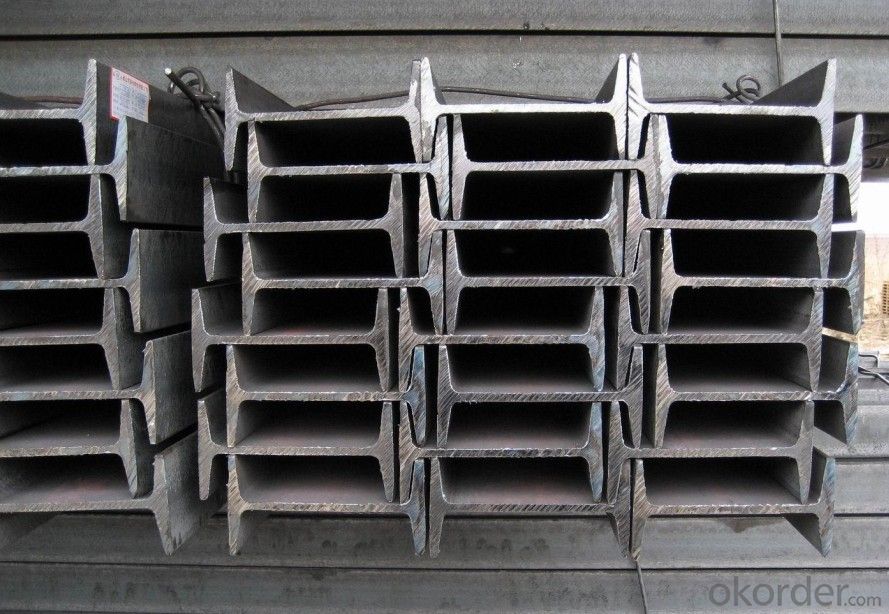
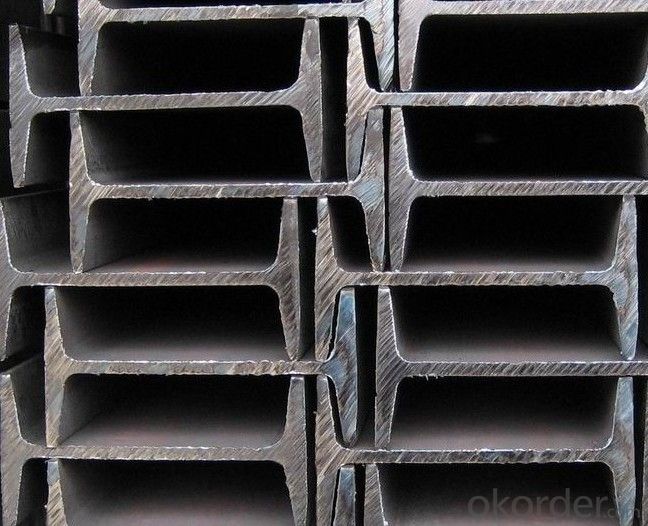
- Q: Can steel I-beams be used in temporary or relocatable structures?
- Yes, steel I-beams can be used in temporary or relocatable structures. Steel I-beams are commonly used in construction due to their strength, durability, and versatility. They can be easily assembled and disassembled, making them suitable for temporary or relocatable structures such as portable buildings, temporary bridges, or event structures.
- Q: What are the common testing methods used to verify the quality of steel I-beams?
- There are several common testing methods used to verify the quality of steel I-beams. These methods ensure that the beams meet the necessary standards and specifications for strength, durability, and safety. 1. Tensile Testing: This method involves subjecting the steel I-beams to a controlled force to measure their strength and elasticity. The beams are pulled until they reach their breaking point, and the test measures the maximum amount of force the beam can withstand. This helps determine if the beams have the required tensile strength. 2. Hardness Testing: Hardness testing measures the resistance of the steel I-beam to indentation or scratching. Common methods include the Brinell, Rockwell, and Vickers tests. By using a specific indenter and applying a known force, the hardness of the material can be determined. This test helps assess the beam's ability to resist wear and deformation. 3. Impact Testing: This method evaluates the ability of the steel I-beams to withstand sudden forces or impacts. The beams are struck with a pendulum or dropped from a certain height, and the amount of energy absorbed during impact is measured. This test determines the beam's toughness and resistance to sudden loading. 4. Ultrasonic Testing: Ultrasonic testing uses high-frequency sound waves to detect any internal defects or inconsistencies within the steel I-beams. A probe is placed on the beam's surface, sending sound waves through the material. Any irregularities, such as cracks or voids, are reflected back to the probe and analyzed. This non-destructive test helps identify hidden flaws that may compromise the beam's structural integrity. 5. Visual Inspection: Visual inspection is a basic method that involves visually examining the steel I-beams for any visible defects, such as surface cracks, welding irregularities, or corrosion. Trained inspectors perform this inspection to identify any issues that may affect the overall quality of the beams. These testing methods, either used individually or in combination, ensure that steel I-beams meet the required quality standards. Proper testing helps guarantee the structural integrity, safety, and reliability of these essential construction components.
- Q: How do Steel I-Beams perform in terms of acoustics?
- Steel I-beams perform poorly in terms of acoustics. Due to their rigid and dense nature, they have a high density and low elasticity, which makes them excellent conductors of sound. This means that when sound waves come into contact with a steel I-beam, they are easily transmitted through the material, resulting in poor sound insulation. This can lead to significant sound transmission between rooms or floors, causing unwanted noise and reducing privacy. Additionally, steel I-beams can create a resonance effect, amplifying certain frequencies and causing echoes, reverberation, and an overall poor acoustic environment. Therefore, if acoustic performance is a priority, alternative construction materials or additional soundproofing measures should be considered.
- Q: What are the advantages of using steel I-beams in construction?
- There are several advantages of using steel I-beams in construction. Firstly, steel I-beams offer superior strength and durability, allowing for the construction of large and tall structures with minimal material usage. Secondly, steel I-beams have a high load-bearing capacity, enabling them to support heavy loads and resist bending or warping. Additionally, steel I-beams are versatile and can be easily fabricated into various shapes and sizes to suit different architectural designs. Lastly, steel I-beams are fire-resistant, making them a safe choice for construction projects.
- Q: How are Steel I-Beams connected together?
- Steel I-beams are typically connected together using methods such as welding, bolting, or using specialized connectors like splice plates or shear connectors. These connections ensure structural integrity and stability in various construction applications.
- Q: Are steel I-beams suitable for multi-story buildings?
- Yes, steel I-beams are indeed suitable for multi-story buildings. Steel I-beams are widely used in construction due to their high strength-to-weight ratio, durability, and ability to span long distances. Their structural properties make them a reliable choice for supporting the weight of multiple floors in multi-story buildings. Additionally, steel I-beams allow for flexible and efficient designs, allowing architects and engineers to create open and spacious interior spaces.
- Q: What are the common design considerations for steel I-beams in high-rise buildings?
- Some common design considerations for steel I-beams in high-rise buildings include the load-bearing capacity, structural stability, fire resistance, and overall cost-effectiveness. The I-beams need to be able to support the weight of the building and its occupants, while also withstanding potential lateral forces such as wind or earthquakes. Fire resistance is crucial to ensure the safety of the building, and cost-effectiveness is important to optimize the construction process. Additionally, factors like material quality, fabrication techniques, and connections between beams are also important considerations in the design process.
- Q: What are the different fabrication methods for steel I-beams?
- The different fabrication methods for steel I-beams include hot rolling, cold rolling, and welding. Hot rolling involves heating the steel billet and passing it through a series of rollers to shape it into an I-beam. Cold rolling is a similar process but is carried out at room temperature, resulting in a more precise final product. Welding involves joining individual steel plates or sections together to form the I-beam shape.
- Q: Why are the rails made of I-beam?
- The type and strength of the rail are represented by kg/m. The heavier the rail, the greater the weight it can bear.
- Q: What are the considerations for steel I-beam design in high-wind speed areas?
- To ensure the structural integrity and safety of steel I-beams in high-wind speed areas, several factors must be taken into consideration: 1. Wind load calculation: Accurate calculation of the wind load is the first step. This involves considering the basic wind speed, the building's exposure category, and the importance factor of the structure. Wind tunnel testing and computer simulations may also be used for precise calculations. 2. Material selection: Choosing the right grade and quality of steel is crucial. High-strength steel is often preferred due to its superior tensile strength and ability to withstand higher wind loads. Corrosion-resistant steel should also be chosen to prevent deterioration over time. 3. Beam size and shape: The size and shape of the I-beam are determined by the wind load calculations. The beam must be designed to resist bending and shearing forces caused by the wind. Increasing the beam's depth and flange width can enhance its stiffness and resistance to bending. 4. Connection design: The connections between the I-beam and other structural elements must be carefully designed to withstand wind loads. Adequate moment and shear connections should be provided to transfer wind forces without compromising structural integrity. 5. Bracing and lateral support: Incorporating bracing and lateral support systems is essential to prevent excessive deflection or buckling of the I-beam. Diagonal braces, cross-bracing, or moment frames can provide stability and increase overall rigidity. 6. Anchorage and foundation design: The foundation system should be designed to resist uplift forces caused by the wind. Proper anchorage of the I-beam to the foundation is critical to prevent displacement during high winds. Anchors, such as anchor bolts or dowels, should be appropriately sized and positioned. 7. Building codes and regulations: Compliance with local building codes and regulations is essential. These codes specify minimum design requirements, construction techniques, and wind load factors that must be followed. Consulting with a structural engineer familiar with local codes is recommended. By considering these factors and following best practices, the design of steel I-beams in high-wind speed areas can be optimized for maximum safety and structural performance.
Send your message to us
European Standard IPE/IPEAA in Material Grade GB-Q235
- Loading Port:
- Tianjin
- Payment Terms:
- TT OR LC
- Min Order Qty:
- 25 m.t
- Supply Capability:
- 10000 m.t/month
OKorder Service Pledge
OKorder Financial Service
Similar products
Hot products
Hot Searches
Related keywords

